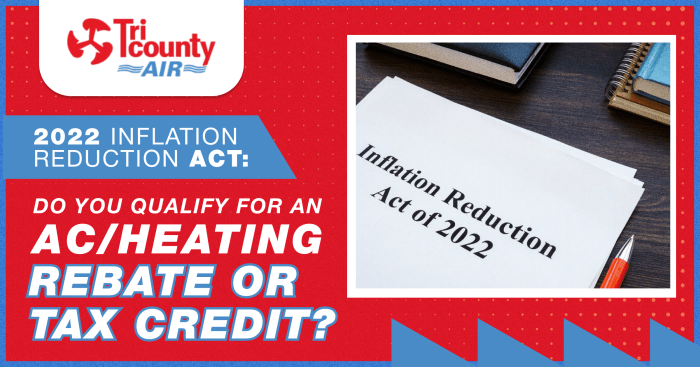
What Does the Inflation Reduction Act Mean for Our Carbon Emissions?
What does the Inflation Reduction Act mean for us carbon emissions? It’s a question on many minds as the landmark legislation aims to tackle climate change and reduce our reliance on fossil fuels. The act, passed in 2022, includes a significant package of investments and incentives aimed at promoting clean energy and reducing greenhouse gas emissions.
The Inflation Reduction Act represents a major shift in US climate policy, and its impact on our carbon footprint is a topic of ongoing debate and analysis. This act sets the stage for a new era of clean energy development and a transition towards a more sustainable future.
The Inflation Reduction Act
The Inflation Reduction Act (IRA) is a landmark piece of legislation passed in 2022 that aims to address climate change, reduce healthcare costs, and lower the federal deficit. While the name suggests a focus on inflation, the IRA contains significant provisions aimed at reducing carbon emissions and transitioning to a cleaner energy future.
Financial Incentives for Clean Energy Investments, What does the inflation reduction act mean for us carbon emissions
The IRA provides substantial financial incentives for individuals and businesses to invest in clean energy technologies. These incentives aim to accelerate the adoption of renewable energy sources and energy efficiency measures, thereby reducing greenhouse gas emissions.
- Tax Credits for Solar Panels:The IRA extends and expands the existing tax credit for residential solar panels, offering a 30% tax credit for homeowners who install solar systems. This credit can significantly reduce the upfront cost of solar energy, making it more accessible to a wider range of households.
- Tax Credits for Electric Vehicles:The IRA provides a tax credit of up to $7,500 for the purchase of new electric vehicles (EVs) that meet certain requirements, including domestic sourcing of battery components. This incentive aims to encourage the adoption of EVs and reduce reliance on gasoline-powered vehicles.
- Tax Credits for Energy Efficiency Upgrades:The IRA offers tax credits for energy efficiency improvements in homes, including upgrades to insulation, windows, and heating and cooling systems. These credits can help homeowners reduce their energy consumption and save money on their energy bills.
Investments in Renewable Energy Infrastructure
The IRA invests billions of dollars in renewable energy infrastructure, supporting the development and deployment of wind, solar, and other clean energy technologies. This funding aims to create jobs, reduce reliance on fossil fuels, and accelerate the transition to a clean energy economy.
- Funding for Wind and Solar Projects:The IRA provides funding for the construction of new wind and solar power plants, including tax credits for renewable energy projects and grants for clean energy technology deployment. This investment aims to increase the share of renewable energy in the U.S.
The Inflation Reduction Act aims to significantly reduce US carbon emissions, and while its focus is primarily on domestic energy production, it also indirectly impacts global climate efforts. This brings us to the new EU climate rules requiring airlines to monitor their vapour trails, which contribute to climate change.
These rules highlight the growing international awareness of the need to address aviation’s environmental impact, an area where the Inflation Reduction Act’s investments in clean energy technologies could potentially lead to innovations that benefit the global aviation sector.
electricity grid.
- Support for Energy Storage:The IRA includes funding for energy storage technologies, such as batteries, which can help to ensure a reliable supply of renewable energy. This support aims to address the intermittency of renewable energy sources, such as solar and wind power, and enhance grid stability.
- Investments in Clean Hydrogen:The IRA provides funding for the development and deployment of clean hydrogen technologies, which can be used as a fuel source for transportation, industry, and power generation. This investment aims to promote the use of clean hydrogen as a sustainable alternative to fossil fuels.
Impact on Renewable Energy Adoption
The Inflation Reduction Act (IRA) represents a significant step towards accelerating the adoption of renewable energy sources in the United States. The act provides a substantial boost to the clean energy sector through tax credits, grants, and other financial incentives, aiming to stimulate investment and create a more favorable environment for renewable energy projects.
Investment Incentives and Tax Credits
The IRA offers a wide range of tax credits and incentives designed to encourage investment in renewable energy technologies. These incentives are crucial for driving the adoption of renewable energy by making projects more financially viable.
- Production Tax Credit (PTC):The PTC provides a tax credit for each kilowatt-hour of electricity generated from renewable sources, including wind, solar, geothermal, and biomass. The act extends and expands the PTC, providing greater certainty and financial support for renewable energy projects.
The Inflation Reduction Act is a big deal for climate change, with its focus on renewable energy and clean tech. It’s a long game, but it’s a game worth playing. Just like Jack Draper’s recent victory against Tomas Machac in the US Open has shown us why he’s a genuine contender , we need to keep pushing forward to see real results.
It’s a marathon, not a sprint, and the Inflation Reduction Act is a powerful tool for us to finally make progress on climate change.
- Investment Tax Credit (ITC):The ITC offers a tax credit for investments in renewable energy infrastructure, including solar panels, wind turbines, and energy storage systems. The IRA extends and expands the ITC, making it more attractive for businesses and individuals to invest in renewable energy.
- Clean Energy Manufacturing Tax Credit:This credit encourages domestic manufacturing of clean energy technologies, including solar panels, wind turbines, and batteries. By supporting domestic production, the act aims to create jobs and reduce reliance on foreign imports.
Carbon Emission Reduction Targets
The Inflation Reduction Act (IRA) aims to significantly reduce greenhouse gas emissions, contributing to the national effort to combat climate change. This act sets ambitious goals for clean energy development and deployment, which are expected to result in substantial reductions in carbon emissions.
Projected Greenhouse Gas Emission Reductions
The IRA is projected to reduce greenhouse gas emissions by 40% below 2005 levels by 2030. This target aligns with the Biden administration’s goal of achieving net-zero emissions by 2050. The projected reductions are based on a combination of factors, including:* Increased adoption of renewable energy:The IRA provides tax credits and incentives for investments in solar, wind, and other renewable energy technologies.
The Inflation Reduction Act is a big deal for climate change, and it’s definitely something we should be talking about. But, honestly, sometimes I just need a break from all the serious news. That’s why I found myself totally engrossed in the news about 90 day fiances big ed engaged to fan he met at a signing.
It’s just so surreal! Anyway, back to the Inflation Reduction Act, it’s definitely going to be interesting to see how it plays out in the long run.
This is expected to lead to a significant increase in the deployment of these clean energy sources, replacing fossil fuels and reducing emissions.
Energy efficiency improvements
The IRA supports energy efficiency upgrades in homes, buildings, and industries. By reducing energy consumption, these measures will contribute to lower emissions.
Investments in clean transportation
The act includes provisions to support the development and adoption of electric vehicles and charging infrastructure. This shift towards cleaner transportation options will further reduce emissions from the transportation sector.
Comparison with Existing Targets and Overall Progress
The IRA’s projected emission reductions represent a significant step towards achieving the national climate goals. The US has committed to reducing emissions by 50-52% below 2005 levels by 2030 under the Paris Agreement. The IRA’s projected reductions are in line with this commitment and contribute to the overall progress towards achieving the goal of net-zero emissions by 2050.However, it’s important to note that achieving these targets will require continued efforts and investments in clean energy technologies and infrastructure.
The IRA provides a strong foundation for these efforts, but ongoing policy support and technological advancements will be crucial to ensure successful implementation and meet the ambitious climate goals.
Economic and Social Impacts

The Inflation Reduction Act (IRA) holds the potential to significantly impact the US economy and society, driving substantial positive changes in various sectors. While the act focuses on addressing climate change, its impact extends far beyond environmental concerns, creating opportunities for economic growth and improving public health.
Economic Benefits and Job Creation
The IRA’s investments in renewable energy technologies and infrastructure are projected to create a significant number of jobs across the country. The act incentivizes the development and deployment of clean energy technologies, such as solar and wind power, which are expected to lead to increased demand for skilled workers in manufacturing, installation, and maintenance.
- The IRA aims to create over 900,000 new jobsin the clean energy sector by 2030, according to the Biden administration. These jobs will span across various industries, including manufacturing, construction, engineering, and research and development.
- A report by the National Renewable Energy Laboratory (NREL) predicts that the IRA’s investments could generate 1.5 million jobsin the renewable energy sector by 2030. This growth is expected to be particularly pronounced in states with abundant renewable energy resources, such as California, Texas, and Illinois.
Social Impacts and Public Health Improvements
The IRA’s focus on reducing greenhouse gas emissions is expected to yield substantial social benefits, particularly in terms of improved air quality and reduced health risks associated with fossil fuel pollution.
- The act’s investments in clean energy are expected to reduce carbon emissions by 40% below 2005 levels by 2030. This reduction in emissions is projected to significantly improve air quality, leading to fewer respiratory illnesses, heart attacks, and other health problems caused by air pollution.
- The IRA’s provisions aimed at promoting electric vehicles are expected to reduce transportation-related emissions, which contribute significantly to air pollution in urban areas. This is expected to lead to improved air quality and reduced health risks for residents of cities and towns across the country.
| Economic Benefits | Projected Impact |
|---|---|
| Job creation in clean energy industries | 900,000+ new jobs by 2030 (Biden administration estimate) |
| Increased investment in renewable energy technologies | Stimulated growth in clean energy sector, leading to economic diversification and innovation |
| Reduced reliance on fossil fuels | Enhanced energy security and reduced vulnerability to price fluctuations in global energy markets |
| Social Benefits | Projected Impact |
| Improved air quality | Reduced respiratory illnesses, heart attacks, and other health problems associated with air pollution |
| Reduced health risks from fossil fuel pollution | Improved public health outcomes, particularly in communities disproportionately affected by air pollution |
| Enhanced environmental sustainability | Mitigated climate change impacts, including reduced sea-level rise, extreme weather events, and ecosystem degradation |
Challenges and Opportunities
The Inflation Reduction Act, while ambitious in its goals, faces several challenges in its implementation. These challenges stem from the complex nature of the energy transition, the need for significant infrastructure upgrades, and the potential for unforeseen economic and social impacts.
However, the act also presents significant opportunities for innovation, job creation, and economic growth, particularly in the burgeoning clean energy sector.
Challenges and Potential Solutions
The success of the Inflation Reduction Act hinges on addressing potential challenges. These challenges, while significant, are not insurmountable. Strategic planning and collaboration among stakeholders can pave the way for a successful transition to a cleaner energy future.
- Infrastructure Development:The act’s success depends on the expansion of renewable energy infrastructure, including transmission lines, storage facilities, and charging stations. This requires significant investments and streamlined permitting processes to ensure timely deployment.
- Potential Solution:Streamlining permitting processes, leveraging public-private partnerships, and incentivizing private investment in grid infrastructure can facilitate the necessary expansion.
- Workforce Development:The clean energy sector requires a skilled workforce to design, build, operate, and maintain renewable energy systems. The act’s success depends on training and upskilling programs to address the anticipated labor shortage.
- Potential Solution:Investing in education and training programs, including apprenticeships and community college partnerships, can create a skilled workforce for the growing clean energy sector.
- Technology Innovation:The act’s success depends on the development and deployment of innovative clean energy technologies. This includes breakthroughs in battery storage, advanced solar technologies, and carbon capture and storage.
- Potential Solution:Supporting research and development, fostering collaboration between universities, industry, and government, and incentivizing private investment in clean energy innovation can drive technological advancements.
- Economic and Social Impacts:The transition to a clean energy economy may lead to job displacement in traditional energy sectors. The act’s success depends on strategies to mitigate these impacts and ensure a just transition.
- Potential Solution:Investing in retraining programs, providing support for workers transitioning to new industries, and fostering economic diversification can mitigate the economic and social impacts of the energy transition.
Opportunities for Innovation and Technological Advancements
The Inflation Reduction Act presents a significant opportunity to accelerate innovation and technological advancements in clean energy technologies. The act’s tax credits and incentives create a favorable environment for investment in research and development, leading to breakthroughs in areas such as:
- Advanced Battery Storage:The act incentivizes the development of advanced battery technologies, which are crucial for grid stability and the integration of intermittent renewable energy sources like solar and wind. This could lead to the development of longer-lasting, more efficient, and cost-effective batteries.
- Carbon Capture and Storage:The act provides incentives for carbon capture and storage (CCS) technologies, which can reduce emissions from existing fossil fuel power plants and industrial processes. This could lead to the development of more efficient and cost-effective CCS technologies, paving the way for their wider deployment.
- Next-Generation Solar Technologies:The act encourages innovation in solar technologies, including the development of more efficient and cost-effective solar panels. This could lead to breakthroughs in thin-film solar, concentrated solar power, and other emerging solar technologies.
International Implications: What Does The Inflation Reduction Act Mean For Us Carbon Emissions
The Inflation Reduction Act (IRA) carries significant international implications, extending beyond its domestic impact on the United States. Its ambitious climate goals and financial incentives for clean energy technologies have the potential to influence climate policies in other countries, contribute to global efforts to address climate change, and shape the landscape of international climate action.
Influence on Climate Policies in Other Countries
The IRA’s substantial investments in renewable energy, energy efficiency, and clean manufacturing create a strong signal to other countries about the direction of the US climate policy. This can encourage similar investments and policy shifts in other nations, fostering a global momentum toward decarbonization.
The act’s success in driving clean energy adoption and reducing emissions in the US could serve as a model for other countries, particularly developing nations seeking to transition to a low-carbon economy. For example, the IRA’s provisions for tax credits on electric vehicles and renewable energy projects could inspire similar incentives in other countries, encouraging the development and deployment of these technologies on a global scale.
Contribution to Global Efforts to Address Climate Change
The IRA’s commitment to reducing greenhouse gas emissions aligns with the goals of the Paris Agreement, a landmark international agreement aimed at limiting global warming to well below 2 degrees Celsius, preferably to 1.5 degrees Celsius, compared to pre-industrial levels.
The act’s contribution to global efforts to address climate change can be seen in several ways. First, the IRA’s ambitious emission reduction targets contribute to the collective global effort to achieve the Paris Agreement goals. Second, the act’s investments in clean energy technologies and infrastructure can drive innovation and technological advancements that benefit the entire world.
Third, the IRA’s focus on climate justice and equitable access to clean energy resources can help address the disproportionate impacts of climate change on vulnerable communities around the globe.
Comparison with International Agreements and Impact on Global Climate Action
The IRA’s provisions can be compared with other international agreements and their impact on global climate action. The act’s focus on domestic clean energy production and deployment aligns with the goals of the Paris Agreement, which emphasizes the need for countries to take ambitious action to reduce emissions.
However, the IRA’s emphasis on domestic production could potentially lead to trade disputes with other countries, especially if it prioritizes US-made products over imported goods. This could create challenges for global cooperation on climate change, as countries might prioritize their own interests over collective action.






